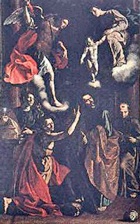

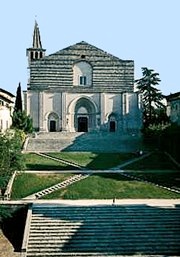
History
Earlier Church
The earliest certain documentation of a church dedicated to St Fortunatus in Todi is in a bull of Pope Celestine III (1191-8) in which he lamented the decadence of the monks of the adjoining Benedictine monastery. Part of this church survives as the Cappella Gregoriana, to the right of the apse. Its history is set out in the page on this chapel.
By 1252, when Pietro Caetani, the uncle of the future Pope Boniface VIII, became bishop of Todi, this church and monastery belonged to the Vallombrosians. Bishop Caetani required them to cede the complex to the Franciscans in exchange for the church of Sant' Arcangelo delle Fontanelle (outside Porta Fratta). However, the Vallombrosians disputed the terms of the transfer, and the terms were not confirmed until 1256 (with the assistance of Pope Alexander IV, who had been the Cardinal Protector of the Franciscans).
The friars brought with them the relics of the Blessed Roger of Todi, one of the early associates of St Francis who had died in 1236 at Sant' Arcangelo delle Fontanelle. Until recently, they were venerated in the sacristy.
The Franciscans of San Fortunato benefitted when Bentivenga dei Bentivenghi, who belonged to their order, became bishop of Todi in 1276. He became a cardinal two years later, at which point his episcopal throne passed to his relative, another Franciscan, Angelario dei Bentivenghi (1278-85). When Cardinal Bentivenga died in 1289, he was buried in San Fortunato, and he left his library to its convent.
Another relative of Cardinal Bentivenga, the future Cardinal Matthew of Acquasparta, entered the convent of San Fortunato in ca. 1260. He remained a supporter of the convent after he became a cardinal in 1288. In 1292, he secured an indulgence from Pope Nicholas IV for those contributing to the construction of a new and larger church for the friars.
The friars accepted the Blessed Jacopone as a lay brother in ca. 1278. In 1294, he was among the radical friars(the so-called the Spiritual Franciscans) who received permission from Pope Celestine V to live separately from the other friars so that they could observe the Franciscan Rule in its primitive form. However, Pope Boniface VIII reversed the privileges and subjected the Spirituals once more to their regular superiors. Blessed Jacopone signed the manifesto of Cardinals Giacomo and Pietro Colonna against Boniface VIII in 1297, and he also wrote scurrilous verse that criticised him. He was therefore imprisoned at Palestrina and excommunicated, and released only after the death of Boniface VIII in 1303.
Stages of Construction
Nicholas IV laid the foundation stone of the new church in 1292, and work began on the acquisition of adjoining properties to make way for its construction. The earlier church remained in use while the two bays of the present church nearest to the apse were built.
In 1296, it was necessary to demolish part of the old church in order to build the new apse itself. It was during this work that the relics of SS Fortunatus, Cassian and Callistus were rediscovered. Pope Boniface VIII consented to their translation to the sacristy of the new church in 1297.
In 1301, Bishop Nicolò Armati acquire the relics of the two female saints for San Fortunato:
Later in 1301, Boniface VIII granted indulgences to those attending the subsequent translation of the relics of the five saints to the high altar of the new church. It is likely that this was an important source of finance for the subsequent phases of construction. These events surrounding what were now deemed to be the five patron saints of Todi brought the Franciscans into an extremely prominent position in the city.
However, a number of factors now conspired to halt the progress of construction towards the present facade. First, there was the practical difficulty of levelling the ground and diverting Via San Fortunato so that the nave could be extended. (The Dominicans of nearby San Leucio strongly objected to this diversion, because the road linked their convent to the centre of the city). Secondly, there were the political and economic difficulties associated with the Ghibelline revolt of 1328 (see below) and with the Black Death (1348).
Work probably resumed when Todi came under direct papal rule in 1367, and things would have been eased when the Dominicans left San Leucio in 1373. However, only in 1405 could the temporary wall across the nave be removed and replaced by another that was one bay nearer to the eventual façade. The final phase of construction, which began in 1415, centred on the last two bays of the nave, the facade and the campanile (1460). The temporary wall across the nave was finally removed in 1461, and the floor paved in 1463.
Later History
The friars of San Fortunato enjoyed the support of the Franciscan Teobaldo Pontano da Todi, whom Boniface VIII appointed as Bishop of Assisi in 1296. In that year, Boniface VIII ordered him to expel the Vallombrosians from Sant’ Arcangelo delle Fontanelle because they continued to harass the friars at San Fortunato. When Bishop Pontani fled from Assisi in 1319 during the Ghibelline Revolt, he took refuge in San Fortunato. He probably commissioned the Cappella di San Francesco there, and is documented as donating an altar dossal to it in 1327.
Life in San Fortunato was disrupted in 1328 when the Emperor Louis of Bavaria moved to Todi during his disastrous split with Pope John XXII. The anti-pope Nicholas V moved to San Fortunato, and the friars preached from its pulpit that John XXII was a heretic. They must have learned to regret their actions when imperial troops sacked their treasury. They were also excommunicated for a short period, but subsequently forgiven.
In 1433 Bishop Antonio da Anagni retrieved and formally recognised the relics of the Blessed Jacopone in the Monastero di Montecristo. He then enclosed them in a wooden sarcophagus and translated them to San Fortunato.
Work on the vaults of the church began in 1457. Bartolomeo di Mattiolo da Torigiano, who was the leading architect at Perugia at this time, was consulted on a number of occasions in 1458 and received a payment for work on the project in 1459-62.
In 1580, Bishop Angelo Cesi commissioned the remodelling of the apse in order to conform to the new liturgical requirements of the Counter-reformation. This required the demolition of the high altar, which in turn required the removal of the relics of the five patron saints of Todi to the sacristy.
Bishop Angelo Cesi also commissioned the construction of the crypt below the apse to provide a permanent home for the relics. This work was complete in 1596: the relics of the five patron saints and those of the Blessed Jacopone were duly translated to new tombs in the crypt (see below) after a procession through the city that lasted for three hours.
The Franciscans were expelled from San Fortunato in 1866, and the convent was converted to a school. The huge flight of stairs that now leads up to the church was built in the early 20th century.
Exterior
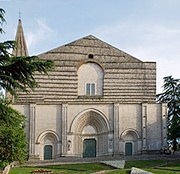
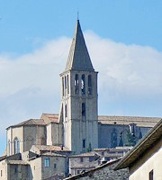
The campanile of San Fortunato was modelled on that of the Franciscans’ mother church in Assisi. Its existence was documented in 1328, but its construction was not completed until 1460. It is possible to climb to its pinnacle. which is the highest point in Todi, for a small fee.
As noted above, work on the church reached the facade in 1415 and continued until 1458. Unfortunately, the upper part of the façade was never completed.
Lions (8th century ?)
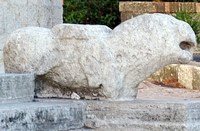
These two lions on the steps in front of the facade probably came from an earlier church on the site.
Portal (1424-36)
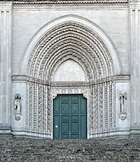
Angel of the Annunciation (15th century)
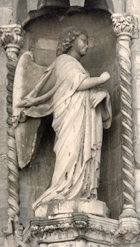
Interior
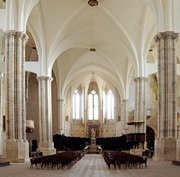
The interior is in the form of a “Hallenkirche” (hall church), so-called because the nave and flanking aisles are of equal height. The nave culminates in a polygonal apse, with the sacristy to the left and the to the Cappella Gregoriana (built on the site of the earlier church) to the right. Light floods in from the tall windows in the apse and above the chapels that line the aisles.
Apse
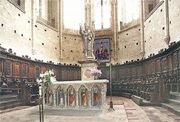
A choir screen across the bay of the nave and aisles that is nearest the apse originally preserved this part of the church for use by the clergy. This screen was demolished in ca. 1580 in line with the requirements of the Council of Trent.
The high altar (14th century) was also demolished, although its columns were re-used in its replacement. Figures of SS Romana, Cassian, Fortunatus, Callistus and Digna (the five patron saints of Todi) were painted on panels between these columns in 1860.
Crucifixion (1590)
The altarpiece on the back wall of the apse, which depicts the Crucifixion with the Virgin and St John the Evangelist, set in front of a cityscape of Todi, is by Pietro Paolo Sensini.
Choir stalls (1581-90)
These new stalls were built by Antonio Maffei along the wall of the apse after the demolition of the original choir. The backs of the first three stalls on each side, and of the bishop’s seat at the centre, have wooden bas-relief statues of patron saints in niches.
St Fortunatus (1643)
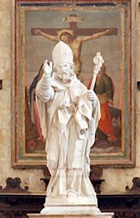
Nave
Water stoup (6th century)
The water stoup near the entrance to the sacristy (to the left of the apse) was made from an architectural fragment decorated with a cross that must have come from an ancient church on the site.
Capitals (13th century)
The water stoup near the 1st pillar on the left of the nave is made from two capitals that probably came from the earlier church. The upper one is carved with a relief of Christ with ears of grain and bunches of grapes emanating from His mouth in representation of the mystery of the Eucharist.
Pulpit (15th century)
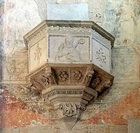
Cappella di San Michele Arcangelo (4th on the right)
Madonna and Child with angels (1432)
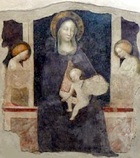
The attribution of the work to this important Florentine painter was first made in 1907 and confirmed by documents discovered in 1914. These recorded two payments to Masolino, in October 1432 and June 1433. The duration of his stay suggests that this fragment was part of a more extensive cycle. The stay followed a period that Masolino had spent in Rome.
Madonna and Child with saints (1506)
“Madonna Vittoria” commissioned this fresco of the Madonna and Child with SS Jerome and George. This last figure is ruined, but the dragon that St George has killed survives.
Cappella di San Francesco (6th on the right)
Scenes from the life of St Francis (ca. 1340)
The surviving frescoes from this cycle by a follower of Giotto are on the right wall. They depict:
-
✴St Francis renouncing his inheritance (in the lunette);
-
✴the stigmatisation of St Francis (on the pilaster); and
-
✴the verification of the stigmata.
Their iconography is based on that of the corresponding scenes in the cycle (1291-7) in the upper church of San Francesco, Assisi.
Crucifixion (ca. 1340)
This fresco on the back wall depicts the Crucifixion with the Virgin and St John the Evangelist. A dead body lies at the foot of the Cross, probably representing a deceased relative of the donor (perhaps Cardinal Bentivenga dei Bentivenghi) who was buried in the chapel.
SS Fortunatus and Nicholas of Bari (ca. 1340)
This well-preserved fresco on right pilaster (above the stigmatisation of St Francis) is attributed to Jacopo di Mino del Pellicciaio. [The physiognomy suggests that the artist was also responsible for the fresco of the Purgatory of St Patrick at San Francesco al Borgo].
Cappella dell’ Annunziata (7th on the right)
This chapel was remodelled in the Baroque style in the 17th century. Its stucco decoration, which is by an unknown follower of Alessandro Algardi, is perhaps the most important work in the Baroque style in Todi. It includes an oval relief of the Annunciation supported by angels above the altar, and reliefs of the Adoration of the Magi and the Adoration of the shepherds on the sidewalls.
Cappella della Vergine di Loreto (6th on the left)
Adoration of the Magi (ca. 1350)
This fresco fragment on the left wall is all that remains of an extensive fresco cycle in this chapel.
Cappella del Crocifisso (5th on the left)
Angels (ca. 1300)
This fragment under the entrance arch is probably the oldest surviving fresco in the church. It was part of a cycle that covered the walls of the chapel, and other traces survive below the later works (see below).
Scenes from the life of St John the Baptist (ca. 1340)
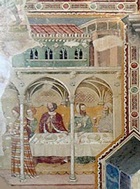
-
✴the presentation of St John the Baptist at the Temple; and
-
✴the banquet of Herod.
They draw on the frescoes (1312-7) by Simone Martini in the Cappella di San Martino of San Francesco, Assisi, and also on the scenes from the Passion (ca. 1319) by Pietro Lorenzetti in the transept of the lower church there.
Maestà (early 15th century)
This fresco on the entrance arch is by a follower of Gentile da Fabriano.
Cappella di San Fortunato (4th on the left)
Reliquary of the arm of St Fortunatus (14th century)
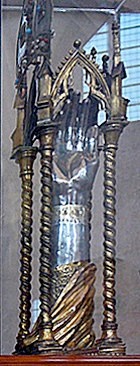
The silver representation of the arm is housed in a gilded tabernacle below a gilded mitre that is decorated with precious stones.
Cappella dell’ Assunta (3rd on the left)
Works by Andrea Polinari (1620)
Mercurio Accursi commissioned Andrea Polinori to redesign and decorate this chapel in 1617. His works in it include:
-
✴the altarpiece of the Presentation of the Virgin at the Temple, above the altar on the left wall, with a fresco of the birth of the Virgin in the lunette above it;
-
✴the altarpiece of the Trinity and the Coronation of the Virgin, above the altar on the right wall;
-
✴a fresco of the Annunciation in the lunette above the altarpiece; and
-
✴other frescoes , which include figures of Moses, David, Solomon and Jeremiah (in the pendentives below the cupola) and SS Peter and Paul (on the entrance arch).
Assumption of the Virgin (1620)
This altarpiece is on the central altar in the chapel is by Giovanni Antonio Polinori (the brother of Andrea Polinori)
Sacristy
The relics of the Blessed Roger of Todi and those of the Blessed Andreuccio (died 1328) were venerated here until their recent translation to the Convento di Montesanto (of which the former was the founder).
The sacristy (to the left of the apse) has often acted as a temporary home for other important relics of San Fortunato:
-
✴those of SS Fortunatus, Callistus, Cassian in 1297-1301;
-
✴those of Jacopone of Todi were moved here from the Poor Clares’ convent of Montecristo in 1433 and moved to the crypt in 1596; and
-
✴those of SS Fortunatus, Callistus, Cassian, Romana and Degna were held here in the period, 1580-96 during the remodelling of the apse and the building of the new crypt.
Reliquary (1759)
This reliquary contains the cranium of the Blessed Jacapone da Todi.
Frescoes (ca. 1350)
These important fresco fragments were recovered when the sacristy was restored in 1923-4. They include the upper part of a Crucifixion (over the altar) that is characterised by a particularly expressive approach to the horror of the scene.
Crypt (1593)
Bishop Angelo Cesi commissioned this new crypt under the high altar.
Sarcophagus of the Five Patron Saints (1596)
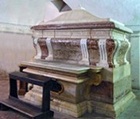
Monument to the Blessed Jacapone da Todi (1596)
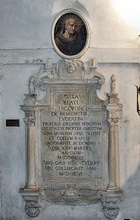
The portrait of the Blessed Jacopone above the monument is by Ferraù Fenzoni da Faenza (il Faenzone).
Work from the Church
Madonna and Child in glory with saints (1592)
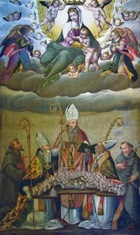
Assumption of the Virgin (1595)
This altarpiece by Pietro Paolo Sensini, which from the Cappella dell’ Assunta (above), is now in the Pinacoteca Comunale. An inscription records that Sensini restored it in 1600. The figure of the Franciscan donor, which was probably over-painted during this restoration, has been recovered].
St Charles Borromeo (1614)
This altarpiece, which is signed by Pietro Paolo Sensini and dated by inscription, is now in the Pinacoteca Comunale.
St Fortunatus cures the Goth (early 17th century)
The Pinacoteca Comunale owns two versions of this work by Pietro Paolo Sensini, which probably came from the public palaces of Todi, only one of which is displayed. A third version, which was dated 1615 and came from San Fortunato, has been lost. The miraculous cure of the Goth commander is shown on the right, and in the main scene the families of the children released as a result give thanks to St Fortunatus.
Madonna and Child in glory with saints (1608)
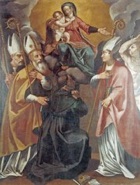
Apparition of Christ (1635)
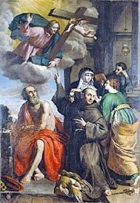
Madonna and Child in glory with saints (1635)
